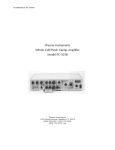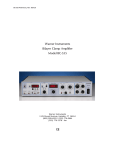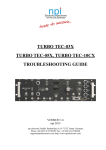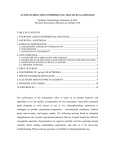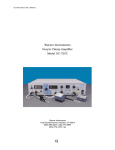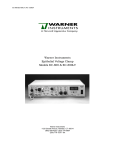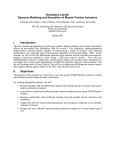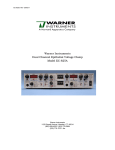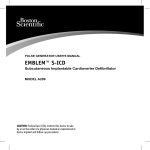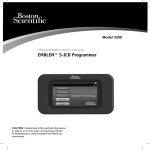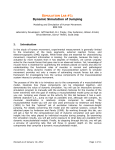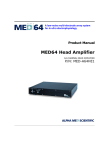Download How to assemble a planar lipid bilayer workstation
Transcript
Warner Instrument Corporation THE DESIGN AND USE OF A PLANAR LIPID BILAYER WORKSTATION While Warner Instruments manufactures a complete solution for the user interested in assembling a planar lipid bilayer workstation, we provide the following information for the user who already has many of the required components and wishes to complete their system. For those with little experience in bilayer work, we suggest a review of Ion Channel Reconstitution edited by C. Miller, Plenum Press, New York, 1986. In particular, Chapter 5, "How To Set Up A Bilayer System", covers many important aspects on the subject. Several other pertinent references are included in the appendix at the back of this manual. Basic design A planar lipid bilayer (BLM) workstation, used to record currents through actively gating, ion conducting single channels, is a complex apparatus requiring several components working in concert. These components include a means to support the lipid membrane, high gain amplification, shielding of electromagnetic interference and mechanical vibration, mechanisms for stirring and changing solutions, signal filtering, data acquisition hardware and software, data analysis software, and a means to archive acquired data. A schematic representation of a basic BLM layout is shown in Figure 1 (see next page). Warner Instruments provides nearly all of the components used in the assembly of a BLM workstation, including Faraday cages, vibration isolation tables, a dedicated bilayer clamp amplifier, high quality signal filtering devices, stirring mechanisms, cups and chambers, and perfusion apparatus. The components listed above may be assembled in various ways to achieve a working system. Regardless of the configuration used, care must be taken in the design of a BLM workstation to minimize both mechanical and electrical noise sources since single channel currents are often only a few pA in magnitude. In this section we describe the basic design of a BLM workstation. Faraday cage A Faraday cage is an enclosure designed to shield the sensitive electronics in the headstage from electromagnetic interference generated by noise sources in the vicinity of the apparatus. These sources include exterior lighting, nearby instrumentation and electrical wiring. The cage can be fabricated from any conducting material and is grounded. While the design of the BC-525C facilitates grounding the Faraday cage through the headstage (see Circuit and chassis grounds), we do not recommend this procedure, but Excerpt from Warner BC-525C user’s manual. Copyright 1999-2000 Warner Instrument Corporation May not be reproduced for commercial use without written permission of Warner Instrument Corporation. 2 Figure 1. Schematic representation of a BLM setup. Stirring Accessories Faraday Cage Headstage Cup/Chamber BC-525C Oscilloscope Computer A/D Converter Warner Instrument Corporation Excerpt from Warner BC-525C user’s manual. Copyright 1999-2000 Warner Instrument Corporation May not be reproduced for commercial use without written permission of Warner Instrument Corporation. 3 Warner Instrument Corporation instead suggest that the cage be grounded through the amplifier circuit and/or chassis grounds. Several Faraday cage designs are available. The most common commercial design is that of a copper or aluminum wire mesh supported on an aluminum frame. This frame attaches to the conducting top of a floor-standing vibration isolation table which completes the cage enclosure and entry is through large front doors. This design is most often used in conjunction with patch clamp setups since the large enclosure can house a microscope as well as several other devices. Another option exclusively presented by Warner Instruments consists of a Faraday cage with enclosed vibration isolation table. This unique combination is specifically designed with the bilayer user in mind. The assembly requires little lab space, rests on a sturdy work surface, and actively isolates the tabletop from the cage enclosure. The cage is easily assembled and has several design features simplifying bilayer work. This cage/table design can be viewed in our catalog or on our web site. Contact our sales office for pricing information on the FC Series Faraday cages. Regardless of the Faraday cage employed, the headstage and membrane support system (e.g. cups and chambers) are contained within the cage which acts as the electromagnetic shield. Other devices such as a perfusion system or stirring apparatus may also be housed within the cage, but many investigators place these components on the outside to reduce their noise contribution. Vibration isolation The isolation and damping of mechanical noise is critical to increasing the signal to noise ratio of a BLM workstation. The significance of this becomes apparent when one considers that the acoustic coupling of normal speech to the buffers on each side of the bilayer is large enough to present a significant capacitance current artefact to the data. Several approaches have been employed to eliminate large amplitude mechanical vibrations in an experimental setup. These include specially designed vibration isolation tables or optical benches. These floor standing benches employ a heavy table top resting on pneumatic supports. Alternatively, investigators have placed heavy concrete slabs (commonly referred to as balance tables) or large steel sheets on partially inflated inner tubes or tennis balls. We recommend the use of a high quality commercial table since these devices provide more long term stability and more effective damp vibrational noise inputs. Another, more subtle source of noise in electrophysiological recording systems is associated with vibration of the headstage. This movement produces a rapidly fluctuating Excerpt from Warner BC-525C user’s manual. Copyright 1999-2000 Warner Instrument Corporation May not be reproduced for commercial use without written permission of Warner Instrument Corporation. 4 Warner Instrument Corporation stray capacitance which appears as increased noise in the amplifier output. This effect can be minimized by shock mounting the headstage to its support. Since it is advantageous to keep the associated moment arm as small as possible, the headstage should be directly mounted to its support rather than through a long connecting rod. Warner Instruments has developed a headstage holder expressly for this purpose. Membrane support The general approach to the formation of a planar lipid bilayer membrane involves spanning lipids across a small hole or aperture in a membrane support. A cocktail of lipids, usually suspended in a solvent such as decane, is manually painted or drawn across the aperture. Excess lipids drain away from the aperture and under hydrophobic pressure the remaining lipids orient themselves into a molecular bilayer. The geometry of the aperture is important to the stability of the supported membrane. If the hole diameter is too large then the membrane formed will be electrically noisy and mechanically fragile. Alternatively, a smaller hole diameter reduces electrical noise and is mechanically more robust, however, the probability that a vesicle will fuse to the membrane is inversely proportional to the membrane size. The most common aperture geometry is that of a simple tubular channel drilled through the supporting septa. This geometry has the advantage of being easy to manufacture and maintain. It is generally assumed that the membrane formed is maintained at one end of the bore. Based on the above discussion, it is clear that the choice of hole size represents a trade-off between membrane noise, fragility, and the probability of vesicle fusion. The best hole size and geometry for a particular application is usually determined empirically. Planar lipid bilayer membranes are routinely generated on a variety of supports including cups made from polystyrene, polysulfone, Teflon, or Delrin. Teflon sheets, Pasteur pipette tips, or plastic septa have also been used. These supports are either custom fabricated for the desired application or are purchased from commercial sources. Currently, the most commonly used system for supporting artificial bilayer membranes is the cup/chamber design. Warner Instruments manufactures and markets cups and chambers in several combinations of material, cup volume and hole size. These may be viewed in our catalog or at our website under the model numbers BCH-13 and BCH-22. Amplification A high-quality amplifier is an absolute requirement for recording single channel currents. The amplifier must be capable of resolving currents as low as 2-3 pA with very little added noise. While several manufacturers produce amplifiers of high-quality, the greatest degree of variation between these amplifiers has been in the design of the headstage. The simplest headstages use resistive feedback circuitry which allows the amplifier to pass currents as Excerpt from Warner BC-525C user’s manual. Copyright 1999-2000 Warner Instrument Corporation May not be reproduced for commercial use without written permission of Warner Instrument Corporation. 5 Warner Instrument Corporation large as 1 nA. More sophisticated bilayer clamp amplifiers incorporate capacitive feedback circuitry in their headstage design. This modification provides dramatically increased noise performance at the expense of large current passing ability. Since bilayer applications seldom generate currents greater than 200 pA, this trade-off is usually not significant. Filtering Filtering of the amplifier output is essential for resolving discrete channel fluctuations from the large amplitude high frequency noise present in the signal. Properly applied filtering is important since over-filtering of the data will obscure or modify channel gating events (a condition to be avoided!), while an under-filtered signal will not clearly resolve single channel events. The BC-525C provides a built-in 8-pole Bessel filter which can be used to select filtering at 100 Hz, 1 kHz, or can be bypassed. Optionally, many researchers filter their data using an external device. These devices are normally of the low-pass 8-pole Bessel design. While Butterworth filters have steeper frequency cutoff characteristics, they are less commonly used since they tend to overshooting a rapidly varying signal thus introducing an artifact into the data. In general, it is better to slightly under-filter the data being acquired in real-time since additional filtering can be performed in the analysis software. A number of filtering devices are marketed by Warner Instruments which can be used in conjunction with the BC-525C to achieve a high degree of filtering resolution. We recommend the use of a high quality 8-pole Bessel filter such as the Warner LPF-8. Acquisition hardware and software Since the analysis of single channel data is statistical in nature, a large number of channel events is required to produce significant results. This condition naturally lends itself to the use of a computer. However, since computers function digitally, the analog signal from the amplifier must first be digitized by an analog to digital (A/D) converter prior to analysis. Many A/D converters are bundled with software which emulates a chart recorder or oscilloscope to aid in data acquisition. Since single channel gating kinetics can range from sub-ms open times to gating transitions lasting several seconds or more, the desired characteristics of a high-quality A/D converter include rapid response times, high signal resolution and low noise. Data analysis Once the data has been acquired and stored, it must be statistically analyzed for its biophysical characteristics. Since the volume of data collected is often exceedingly large, analysis is usually performed by dedicated software programs. The single most popular Excerpt from Warner BC-525C user’s manual. Copyright 1999-2000 Warner Instrument Corporation May not be reproduced for commercial use without written permission of Warner Instrument Corporation. 6 Warner Instrument Corporation program for this purpose is pClamp, marketed by Axon Instruments, Inc. (Burlingame, CA). However, several competing software packages are available commercially or on the Internet. In addition, many investigators have written their own programs to address their specific issues. Data archival The ability to easily archive and retrieve data is an important component of a BLM workstation. During the course of an average experiment, a large volume of data is collected for later analysis. Several devices are commercially available for data storage. These devices include, but are not limited to: VCR tape (requires a signal converter or pulse code modulator), DAT tape, analog tape, portable or removable hard drives, Zip or Jazz drives, or the newer CD-R/CD-RW technology. An advantage of these archival systems is that they allow selective access to previously recorded data for subsequent analysis. The choice of the proper system to be used will depend upon the needs of the researcher, the financial resources available, and the type of data acquired (fast or slow channel kinetics resulting in large or small file sizes). Stirring Stirring of solutions in the recording chamber is important for the production of reproducible results, especially following the addition of agonists or antagonists. Additionally, stirring facilitates the fusion of vesicles to the bilayer membrane prior to recording data, presumably by vibrating the bilayer membrane or continuously introducing new vesicles to the membrane. Ideally, the stirring process should produce sufficiently little mechanical noise such that one is able to make recordings while simultaneously stirring. Perfusion Exchanging of solutions (termed perfusion) normally occurs following incorporation of a channel to the bilayer membrane, or when experimental conditions require an alteration in ionic conditions or the removal of a previously added compound. Under ideal circumstances a good perfusion system is capable of exchanging solutions in the recording chamber without interrupting the recording process or rupturing the membrane. However, most researchers do not attempt to make recordings while perfusing since this is likely to result in a broken membrane. Several techniques for solution exchange are available. These include gravity feed and pump driven devices or manuallyapplied pressure driven systems. In general, fresh solution is added to the bottom of the recording chamber while the perfusate is removed from the top. Excerpt from Warner BC-525C user’s manual. Copyright 1999-2000 Warner Instrument Corporation May not be reproduced for commercial use without written permission of Warner Instrument Corporation. 7 Warner Instrument Corporation Oscilloscope While many investigators use software emulated display devices coupled to their acquisition hardware to view data as it is being acquired, others rely on dedicated instrumentation for this purpose. These dedicated instruments include chart recorders and oscilloscopes. The primary advantage of an oscilloscope over a chart recorder is one of speed. A chart recorder, however, produces a permanent record that is lacking in an oscilloscope. Software emulation usually models one of these hardware devices. Regardless of whether the investigator uses a chart recorder, an oscilloscope, or a software emulated device, the data is previewed during acquisition and is stored for subsequent analysis. Excerpt from Warner BC-525C user’s manual. Copyright 1999-2000 Warner Instrument Corporation May not be reproduced for commercial use without written permission of Warner Instrument Corporation. 8 Warner Instrument Corporation OPERATION The general procedure is to first set up the bilayer chamber, add solutions and make electrical contact. This is followed by adjusting the input offset and forming the bilayer membrane. The procedure for incorporation of channel containing membrane vesicles to the bilayer will depend on the system under study, but will normally proceed by adding vesicles to one side of the membrane under the appropriate ionic and/or osmotic conditions. Once a channel has been successfully incorporated into the bilayer the solutions are perfused and initial experimental conditions established. At this point recording of data proceeds. Setup of the bilayer chamber Bilayer membranes are formed across an aperture in a septum which separates two chambers. The most common configuration is that of a cup (which supports the aperture) placed inside a holder. The interior of the cup represents one chamber while the interior of the holder is the other chamber. The cup wall is the septum. Electrical connections are made via agar salt bridges into each chamber. The whole assembly must be shielded from electrical and vibrational interference to obtain low noise recording of bilayer currents. The aperture must be prepared to accept lipids prior to membrane formation. This is achieved by ‘coating’ the hole with the lipid cocktail before adding solutions to the cup or chamber. Several techniques are employed to coat the hole prior to membrane formation. While the choice of technique used will depend on your application, the materials at hand, and your ingenuity and training, two methods are presented below. One method used to coat the hole is to insert several lipid covered hairs from a Red Sable paintbrush through the aperture. The brush is then revolved in a small circle until the hole is uniformly coated with lipid. (Use a size 00 or 000 Red Sable artists dotting brush which has been trimmed to present 3-5 hairs of the same length. The brush is cleaned and dipped into the lipid cocktail before coating the hole.) An alternative method uses a small (1-2 mm) ball formed on the end of a glass rod or Pasteur pipette with a Bunson burner. The rod is used to apply lipids to the outside rim of the hole. An advantage of this second technique is that it is relatively easy to keep the glass rod, and hence the resulting membrane, free from contamination. Once the hole has been coated, the cup is inserted into the chamber and both the cup and chamber filled with the appropriate solutions. The headstage leads should not be directly connected to the bath solutions. Instead, the leads are routed to wells containing a salt solution which are in turn connected to the solution baths via agar salt bridges. The salt bridge wells should ideally contain the same solution used in the formation of the salt bridge, usually 1 M KCl. In addition, these wells should be adjacent to the baths so that the agar bridges used to complete the circuit from well to bath are as short as possible. The supplied sliver-wire electrodes require chloride-plating prior to their first use and insertion into the salt bridge wells. (See Chloriding electrodes) Excerpt from Warner BC-525C user’s manual. Copyright 1999-2000 Warner Instrument Corporation May not be reproduced for commercial use without written permission of Warner Instrument Corporation. 9 Warner Instrument Corporation Input offset Prior to forming a bilayer membrane, the resistance of the aperture is exceedingly low, as small as 1 kΩ. Consequently, a small input voltage of only 10 mV can induce a relatively large 10 nA current to flow. This current is much larger than the pA currents typical in single channel recording and will overload the headstage integrating capacitor such that reset (capacitor discharge) cannot take place. Since the reset circuitry is disabled by this condition, and the Im meter and output readings will be in error. The meter will indicate zero current while the Im output will either be at zero or the positive or negative extremes. In addition, a series resistance within the electrical pathway can introduce a bias in the voltage applied to the membrane resulting in a systematic offset in the data acquired. It is therefore important to adjust the input offset potential to compensate for these conditions. Input offset adjustment The INPUT OFFSET control provides up to ±120 mV DC at the headstage to compensate for input errors and solution junction potentials. Adjustment of the offset to zero is aided by the input overload LED’s marked high and low. In the absence of a membrane, adjust the INPUT OFFSET control until both LED indicators are unlit. The control should be advanced slowly since a small change in rotation will result in a large change in the current through the open aperture. When both LED’s are off, the offset voltage will be near zero and the Im current can be accurately read on the meter or from the Im OUTPUT BNC. In general, it will be extremely difficult to set the Im current precisely to zero. It is sufficient to adjust the input offset until both the high and low LED indicators are both unlit. At this point the INPUT OFFSET meter reading will indicate the input to bath ground potential difference. If this potential difference is large (greater than 10 mV for normal Ringer solution), then it is advisable to clean and re-chloride the silver wire electrodes (see Chloriding electrodes) and check the agar bridges for deterioration or bubble formation. The potential difference reading should be noted prior to forming the bilayer membrane and rechecked at the end of the recording session to determine stability of the electrodes. NOTE: Do not make adjustments to the INPUT OFFSET control once a membrane has been formed as this will introduce a bias into your data. Bilayer formation Current through the open aperture will be quite high until lipid covers it. Therefore, by monitoring Im in the presence of a small applied voltage, you can easily determine when the aperture is covered. In general, you will observe a dramatic drop in current as soon as lipid has filled the aperture. To perform this, set Vc HOLD (in the COMMANDS block) to the off position, place the OPERATE/STANDBY switch in the operate position and turn the CAP TEST function on. Prior to membrane formation the triangular wave generated by CAP TEST will induce a current which exceeds the operational range of the amplifier input. This results in the appearance of a Excerpt from Warner BC-525C user’s manual. Copyright 1999-2000 Warner Instrument Corporation May not be reproduced for commercial use without written permission of Warner Instrument Corporation. 10 Warner Instrument Corporation full scale (10 V p-p) pseudo-square wave at the Im OUTPUT. During membrane formation the initial covering of the aperture by lipid dramatically decreases the amplitude this square wave allowing you to observe the formation of the molecular bilayer. As the bilayer forms you will observe a time-dependent increase in the amplitude of the square wave representing an increase in membrane capacitance. This capacitance increase is proportional to the area of the forming membrane and so allows you to estimate both the size and stability of the bilayer thus formed. (For discussion see Membrane capacitance calculations.) If you are using the brush technique, then the bilayer membrane is initially formed by painting lipids across the hole. This is achieved by dipping a clean brush in the lipid cocktail and drawing a thin lipid film across the open aperture (reminiscent of making bubbles when you were a kid). Alternatively, the membrane can be formed by momentarily occluding the hole with the end of a glass rod which has been dipped into the lipid cocktail. In either case, the lipids will initially occlude the hole in a thick layer. After a short time (several seconds to a few minutes), excess lipids will drain away from the hole until a molecular bilayer is formed. The area of the forming bilayer membrane can be monitored on an oscilloscope. In general, several attempts of the above procedure may be necessary before a stable membrane is formed. Once the membrane has formed and appears stable, CAP TEST should be turned off and the leak conductance of the membrane checked. A good membrane will have a conductance of less than 10 pS (i.e., 1pA/100mV). Commands Once a stable membrane is formed, the appropriate ionic and/or osmotic conditions are established and channel bearing vesicles are added. The system is monitored in the presence of a transmembrane holding potential for a vesicle ‘fusion event’. Once a channel has incorporated into the bilayer membrane the solutions are quickly perfused to prevent further vesicle fusions and the appropriate experimental conditions established. Command voltages to the bilayer membrane are effected by the Vm HOLD control, by an externally applied signal (CMD IN) or by a combination of the two. Vm HOLD provides a DC potential of either polarity up to 200 mV. External signals at CMD IN are attenuated by x0.1, x0.01, or x0.001. Therefore, a 1 V square wave at CMD IN results in an applied square wave command of 100 mV, 10 mV, or 1 mV, respectively. Excerpt from Warner BC-525C user’s manual. Copyright 1999-2000 Warner Instrument Corporation May not be reproduced for commercial use without written permission of Warner Instrument Corporation. 11 Warner Instrument Corporation THEORETICAL CONSIDERATIONS Shielding Proper shielding of all cabling and recording apparatus are important in maintaining a large signal-to-noise ratio. The necessity of a high quality Faraday cage to protect the headstage from stray input signals cannot be over emphasized. If the noise levels are still unacceptably high after shielding, it may be possible to further reduce noise by wrapping all wiring between the Faraday cage and amplifier in aluminum foil and grounding the foil cover. However, under normal circumstances this should not be necessary. If the user chooses to wrap the wiring in foil, care should be taken to reduce stray capacitance due to movement of the aluminum foil shield. Grounding Since a large signal-to-noise ratio is important in single channel recording, the effort to eliminate ground loops in the circuit wiring gains significance. If your Faraday cage encloses a number of devices (e.g., microscope, stirrers, stepper motors, etc.), then the most common procedure is to create a central grounding location within the cage to which all instrumentation is attached. This is most readily achieved by the formation of a "star ground” and is diagrammed in the upper figure on page 26 (central node grounding scheme). Mount a solid brass bar with a number of attachment points to the inside of the Faraday cage and connect the cage and grounds of all devices within the cage to this bar. The bar is then connected via a 14-16 gauge braided copper wire to an external central ground point which acts as the absolute reference for all devices. NOTE: If the Faraday cage is grounded to the star ground, then do not ground the cage to the headstage. Alternatively, if you use a small Faraday cage which does not contain numerous devices, then you can greatly simplify the circuit wiring by connecting the Faraday cage directly to the headstage ground jack. This design is also diagrammed on page 26 (common mode grounding scheme). The major differences between this scheme and the one described above is 1) the Faraday cage is grounded through the amplifier headstage and 2) the Faraday cage is not connected to the external ground. NOTE: Do not connect the Faraday cage to any other ground point. The choice of which configuration to use depends on the number of components available and the response of your system to noise inputs. In general, if you have a large Faraday cage which encloses numerous devices which require grounding, then it is better to use the central node grounding scheme since the multiple of devices will tend to generate large induced currents in the ground plane which can overwhelm the headstage. On the other hand, if your setup is relatively simple, then grounding the Faraday cage through the headstage will provide a simpler circuit with lower noise. Excerpt from Warner BC-525C user’s manual. Copyright 1999-2000 Warner Instrument Corporation May not be reproduced for commercial use without written permission of Warner Instrument Corporation. 12 Warner Instrument Corporation For either configuration, the chassis ground for all external devices should be attached to a single external ground point. The BC-525C has two grounding posts on the rear of the instrument, one for CIRCUIT GROUND and the other for CHASSIS GROUND. The schemes shown below and described above indicate connection of the BC-525C CHASSIS GROUND to the external ground point. However, it is often advantageous to try different ground configurations with the BC-525C to determine which works best in your environment. NOTE: We do not recommend connecting the BC-525C CIRCUIT GROUND (directly or indirectly) to the oscilloscope chassis ground. Doing so will create a ground loop and increase noise levels within the data. This condition can be avoided by disconnecting the oscilloscope chassis ground from the common ground point when connecting the BC-525C CIRCUIT GROUND to the external ground. Figure 2a. Central node grounding scheme. Note the grounding block within the Faraday cage is connected to the external star ground point and the headstage is not externally grounded. Figure 2b. Common mode grounding scheme. Note the grounding block within the Faraday cage is directly connected to the headstage. This mode only works for small cages containing few devices due to the ground currents involved. Excerpt from Warner BC-525C user’s manual. Copyright 1999-2000 Warner Instrument Corporation May not be reproduced for commercial use without written permission of Warner Instrument Corporation. 13 Warner Instrument Corporation Chloriding electrodes Silver-silver chloride electrodes act as signal transducers by converting ionic currents in solution to an electric current within a wire. This is achieved by utilizing a reversible oxidation/reduction reaction between the electrode and Cl- ions in solution. The chemical reaction is: Cl- + Ag ⇔ AgCl + eThe potential developed by one electrode is proportional to the standard electrochemical potential for Ag/AgCl plus the Cl- concentration at the solution/electrode interface. Since this potential is dependent on Cl-, a voltage bias will be introduced by changing the solution Clconcentration. Therefore, we recommend that Ag/AgCl electrodes be connected to the bath through agar salt bridges to maintain a constant Cl- concentration near the electrode. In addition, the isolation provided by the agar bridge will prevent Ag+ ions from contaminating the baths. The BC-525C is shipped with two silver wires which must be chlorided prior to use. Over time, the AgCl coating on the wires will deteriorate. This will be most apparent as a gradual increase in the junction potential at the beginning of each experiment. In addition, the electrodes may lose their purple-brown color. Once it has been determined that the electrodes require cleaning, the oxide should be removed and re-applied. Techniques for chloriding silver wires Before using Ag wire as a current or voltage electrode, it must first be chlorided. New (previously unused) wire should be cleaned with ETOH before chloriding, while previously chlorided wire should have the old chloride coating removed. A direct approach in removing an old Ag/AgCl coating is to abrade the surface with an extra fine grit sandpaper or Emory cloth. Some investigators, however, shun this technique because of the potential to leave sandpaper oxides imbedded in the metal. Another technique is to repeatedly, very quickly pass the wire through a flame until the old coating is removed. Since silver wire is very soft and has a low melting point, disadvantages to this approach include incorporating oxides into the metal and destroying the wire. A final method in common use is the electroplating technique described below. As with a new wire, clean a de-coated wire with ETOH before proceeding to remove finger oils. Two methods are commonly used to chloride a clean Ag wire; soaking in household bleach or electroplating using a voltage source. Each method is described below. A) Soaking in bleach - This technique places a very useable, but relatively thin coating on the wire. Simply immerse the clean wire in full strength common household bleach (Clorox) for 15 to 30 minutes until a purple-gray color is observed. Rinse and use. Excerpt from Warner BC-525C user’s manual. Copyright 1999-2000 Warner Instrument Corporation May not be reproduced for commercial use without written permission of Warner Instrument Corporation. 14 Warner Instrument Corporation B) Electroplating – While this technique required more effort, it places a thicker and more uniform coating on the silver wire. Electroplating a silver wire with chloride is achieved by making the wire positive with respect to a solution containing NaCl (0.9%) or KCl (3M) and passing a current through the electrode at a rate of 1 mA/cm2 of surface area for 10-15 seconds or until adequately plated (a 1 cm length of 1 mm diameter wire will require approximately 0.3 mA). The color of a well plated wire will be purple-gray. Periodic reversal of the polarity while plating the electrode tends to yield a more stable electrode. When electroplating a previously plated wire, you may find that it does not plate evenly. Complete removal of the residual silver chloride is usually necessary to effect a uniform coat. Before making the wire positive to the chloriding solution, reverse the polarity for 5 to 10 seconds to remove any remaining chloride that might be left in pits on the wire. Then proceed as described above. Membrane capacitance calculations It is possible to theoretically derive an equation to determine the size of the molecular bilayer formed across the aperture. While this equation will probably not yield an exact result (most likely due to variation in the dielectric constant of your lipid mixture), it will give a reasonably approximate result. Recall that we examine the formation of the bilayer by applying a triangular wave to the membrane and observing a square wave at the Im output. The reason we see a square wave is that a capacitor returns the derivative of the applied voltage, as shown in the equations on the next page. However, under normal circumstances you will most likely dispense with a calculation and visually determine if the membrane size is appropriate by examining the amplitude of the square wave on the oscilloscope. From physics, we know that the equation describing the capacitance of a parallel plate capacitor in the MKS system of units is C =ε A d (1) where C is the capacitance (in Farads), ε is the dielectric constant of the material between the plates, A is the area of the plates and d is the plate separation (both in meters). Likewise, we know that that the steady-state charge on a capacitor can be expressed as q = CV (2) where q is the charge on one capacitor plate (in Coulombs) and V is the potential between the plates (in Volts). Equation (2) can be dynamically expressed by taking the time derivative of the charge, thus Excerpt from Warner BC-525C user’s manual. Copyright 1999-2000 Warner Instrument Corporation May not be reproduced for commercial use without written permission of Warner Instrument Corporation. 15 Warner Instrument Corporation i=C where the current i= dV dt (3) dq is defined as the time rate of change of the charge. Substituting dt equation (1) into equation (3) yields the general equation, i =ε A dV . d dt (4) Recall that a bilayer membrane is electronically represented as a capacitor, and that we monitor the forming bilayer through the application a triangular wave. Since a triangular wave, by definition, has a constant rate of change of applied voltage, dV is constant. Likewise, since dt ε is an intrinsic property of the lipid mixture, it is also a constant. Now consider the forming bilayer membrane. Once a sufficient quantity of lipids have drained away from the aperture, the remaining lipids begin to form a molecular bilayer. Since the distance, d, separating both sides of the membrane (the plates of our hypothetical capacitor) is fixed by the length of the lipid tails, this term will also become a constant. Therefore, the only remaining variable on the right side of equation (4) is the area, A, of the forming bilayer. Thus we can express our equation as i = kA (5) where i is the current appearing at the Im output, k is a constant of proportionality, and A is the area of the forming membrane. It should be apparent from the preceding discussion that the magnitude of the current, and hence the amplitude of the resulting square wave, is linearly proportional to the area of the bilayer membrane. Since the amplifier output is scaled to 1 mV/pF when the BC-525C is in CAP TEST mode, application of the preceding discussion to the amplifier indicates that the measured capacitance of a membrane is simply the amplitude of the square wave (expressed in mV) divided by the instrument gain. For example, a 100 pF membrane would yield a 1000 mV square wave (p-p) when the amplifier gain is set to 10 mV/pA. Excerpt from Warner BC-525C user’s manual. Copyright 1999-2000 Warner Instrument Corporation May not be reproduced for commercial use without written permission of Warner Instrument Corporation. 16 Warner Instrument Corporation SUGGESTED REFERENCES 1. Ion Channel Reconstitution edited by C. Miller, Plenum Press, New York (1986). In particular, chapter 5, "How to set up a bilayer system" covers many important aspects on the subject. 2. Single-Channel Recording edited by B. Sackman and E. Neher, Plenum Press, New York (1985). 3. Reconstituting channels into planar membranes: a conceptual framework and methods for fusing vesicles to planar bilayer phospholipid membranes. F.S. Cohen and W.D. Niles, Methods in Enzymology, 220:50-68 (1993) 4. Planar bilayer recording of ryanodine receptors of sarcoplasmic reticulum. R. Coronado, S. Kawano, C.J. Lee, C. Valdivia, and H.H. Valdivia, Methods in Enzymology, 207:699-707 (1992) Excerpt from Warner BC-525C user’s manual. Copyright 1999-2000 Warner Instrument Corporation May not be reproduced for commercial use without written permission of Warner Instrument Corporation. 17 Warner Instrument Corporation GLOSSARY A/D converter – Analog to Digital converter. Computers are inherently digital while the voltage or current output from an amplifier is analog. Therefore, a signal must be first converted to a digitized form before a computer or its software can accept it. Desirable features in an A/D converter include rapid signal conversion, small-step resolution and low noise. analog – Continuous or non-discrete. Often dynamically varying. Compare to: digital. bandwidth – The range of frequencies a device is capable of processing with minimal distortion. A bandwidth of 1 Hz indicates that the device can faithfully process a signal occurring once per second (1 Hz). The larger the bandwidth, the faster the device. Bessel filter – A device used to attenuate the high frequency components of a signal. The cutoff frequency of a filter is normally defined as the frequency at which the strength of the signal is attenuated by 3 dB (10-fold decrease in power). A higher order filter (i.e., 8-pole vs. 4pole) will attenuate the high frequency components more rapidly. An 8-pole Bessel filter attenuates at 14 dB per octave. BLM – Bilayer Lipid Membrane. The molecular bilayer formed from the orientation of lipids such that their polar heads and hydrophobic fatty acid tails are in register. In an aqueous environment, the polar heads face away from the membrane leaving the hydrophobic domains within the bilayer. Historically, Black Lipid Membrane from the effect of interference at the upper and lower faces of the thin film formed, resulting in cancellation of all visible wavelengths. When the membrane thinned appropriately, it would ‘disappear’ or become black. BNC connector – A type of connector used to connect coaxial cables to high frequency electronic equipment. cap comp – See: capacity compensation. capacitance – A capacitor can be represented by a small break in a conducting pathway bounded by two parallel plates. The electric field generated across the space between the plates in the presence of an applied voltage maintains a charge density on each plate. The numerical measure of a capacitor’s ability to maintain charge separation at a given potential is its capacitance. Capacitors effectively block DC currents while passing AC currents. Has units of Farad (F). capacity compensation – The process wherein the current generated when charging a capacitor is subtracted (or compensated) from the output signal. channel conductance – See: unitary channel conductance chassis ground – A connection used to link the amplifier chassis to an external potential. Excerpt from Warner BC-525C user’s manual. Copyright 1999-2000 Warner Instrument Corporation May not be reproduced for commercial use without written permission of Warner Instrument Corporation. 18 Warner Instrument Corporation circuit ground – The potential to which all other potentials within the circuit are referenced. Also, a connection used to link the reference potential of the amplifier circuit to an externally defined potential. CMD IN – Command Input. An external input into the BC-525C allowing the application of user defined command voltages to the headstage. Connection is via BNC. command sensitivity – Selectable scaling of CMD IN input. Attenuation values of CMD IN are x0.1, x0.01, and x0.001. command voltage – The voltage applied to the headstage resulting in a desired transmembrane potential in the system under study. control blocks – Organization of controls on the amplifier into functional groups. Blocks are delineated by titled blue boundaries. current-voltage relationship – A measure of the way in which the current varies as a function of the applied voltage. In an Ohmic device (obeys Ohm’s law), this relationship is linear. An understanding of the current-voltage relationship of a channel yields information about that channel’s function. depolarization – A biological membrane in which charge separation has resulted in transmembrane voltage is termed ‘polarized’. Electrically, depolarization refers to any action which tends to reduce the degree of polarization. Biophysically, a polarized membrane has a resting transmembrane potential between –40 and –90 mV, relative to the inside of the cell. An action which tends to increase the polarization (e.g., increase the transmembrane potential to, say, -100 mV) is termed hyperpolarization, while depolarization refers to any action which decreases the transmembrane potential. (It should be noted that by this definition, a transmembrane potential of +100 mV is still depolarized.) digital – Quantized or discrete. Normally refers to information manipulated by a computer. All processes within a computer are discrete and are composed of 0’s and 1’s. The universe we interact with is functionally analog, therefore information we wish to manipulate with a computer must be digitized prior to use by the computer. DIN connector – Deutsche Industrie Norm. A German standard for electronic and industrial products. DIN connectors can be 3 to 6 pin plugs with the same outer diameter and appearance. electrode – One terminal of a voltage source which can either supply or collect current. Excerpt from Warner BC-525C user’s manual. Copyright 1999-2000 Warner Instrument Corporation May not be reproduced for commercial use without written permission of Warner Instrument Corporation. 19 Warner Instrument Corporation electromagnetic – From physics. An electric current induces a magnetic field and a changing magnetic field induces an electric current. Therefore, these two entities are related to each other and are combined into electromagnetism. electrophysiologist – A scientist who combines the disciplines of physics, electrical engineering, and physiology to the study biological systems. Faraday cage – A grounded conducting enclosure which shields its interior from external electric fields. Named after Michael Faraday, who first described the effect in 1875. gain – The numerical value of the amplification of a signal by an amplifier. User selectable in the OUTPUTS block of the amplifier. gain telegraph – A defined voltage dependent on the gain setting appearing at the associated BNC at the rear of the amplifier. Used to communicate the gain setting to external devices. ground loop – A loop formed from multiple connections into the circuit ground plane by the same device. The flux of magnetic fields through this loop can induce small currents within the ground plane resulting in increased noise in the circuit. Careful consideration of the interconnection between several devices is often required to identify ground loops. headstage – A low gain amplifier placed as close to the preparation as possible. Used to amplify small currents to a range sufficient for the main amplifier to accept. Im – A measure of the current passed through an open channel in the presence of a driving force. Operationally, the current appearing at the Im OUTPUT of the amplifier. intracellular – Situated or occurring within a cell. junction potential – A difference in conductivity between two dissimilar materials will appear as a small voltage when the two materials are brought into contact. This voltage is termed the junction potential. LED – Light Emitting Diode. The red, green or yellow lighted indicators on the front of many devices. LED’s are preferred indicator light sources due to their low power consumption. mean closed time – The average length of time a gating channel will remain in the closed state. mean open time – The average length of time a gating channel will remain in the open state. mini-jack – A small plug on the headstage to which the electrodes are attached. model cell – An electric circuit designed to model the electrical characteristics of a biological membrane. open probability – The calculated probability of finding a channel open at time t, given that the channel is in a closed state at time t=0. Excerpt from Warner BC-525C user’s manual. Copyright 1999-2000 Warner Instrument Corporation May not be reproduced for commercial use without written permission of Warner Instrument Corporation. 20 Warner Instrument Corporation oscilloscope – A device used to monitor voltages within an electrical circuit. output current – See Im output sync – A pulsed signal appearing at the OUTPUT SYNC BNC on the instrument rear panel. Used to synchronize the PULSE GENERATOR or CAP TEST signal to an external device such as an oscilloscope. periodic – That which repeats itself at regular intervals. perfusate – The solution being perfused. perfusion – The exchange of one solution with another. planar lipid bilayer – See BLM. plasma membrane – The surface membrane of a cell. Contrast with an intracellular membrane which is a membrane contained entirely within the cell. potentiometer – A single- or multi-turn dial used to make a continuously varying selection with a range. In its heart this is a variable resistor. pulse code modulator (PCM) – A device which converts an analog signal into a form acceptable for storage on VCR tape. Also converts data previously stored on VCR tape back into an analog signal. reset – An operation wherein the collected charge on the integrating capacitor in the headstage is dissipated, readying the system for further use. signal polarity – Defined as the sign applied to a current generated through a membrane in the presence of an applied holding potential. The electrophysiological definition is determined by the membrane such that an outward directed current and a depolarizing potential are both positive. single channel – Refers to a solitary channel protein functioning within a measurement milieu. step potential – A functionally instantaneous change in potential from one value to another. time constant – In a system governed by exponential kinetics this is the time required for a value to change to 1/e of its initial value, where e=2.71828 is the base of the natural logarithm. transient – Momentary. transmembrane – That which spans a membrane or is referred from one side of a membrane to the other. trim pot – An adjustable variable resistor used for making fine adjustments to a circuit. Excerpt from Warner BC-525C user’s manual. Copyright 1999-2000 Warner Instrument Corporation May not be reproduced for commercial use without written permission of Warner Instrument Corporation. 21 Warner Instrument Corporation TTL – Transistor, Transistor Logic. Voltage ranges used to define an on or off state in binary devices. 0-0.8 V defines a logic 0 state and 2.4-5.0 V defines a logic 1 state. unitary channel conductance – A measure of the ability of a channel to pass an ion from one side of the membrane to the other. An intrinsic property of a single channel which depends on the ionic species under consideration. Determined by measuring the current through an open channel in the presence of a driving force (transmembrane potential) at different potentials. Measurements made within the Ohmic range of the channel’s response will graph as a straight line. The slope of this line when plotted as current (I) vs. potential (V) will yield the conductance (or inverse resistance) of the channel under these conditions. Vm hold – The transmembrane potential generated by the amplifier and applied to the headstage. This driving force appears in addition to any other driving forces which may be present. VC – The user selected potential set in the COMMANDS APPLIED TO REFERENCE block of the amplifier. Excerpt from Warner BC-525C user’s manual. Copyright 1999-2000 Warner Instrument Corporation May not be reproduced for commercial use without written permission of Warner Instrument Corporation.





















